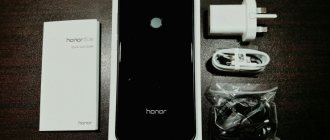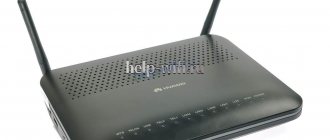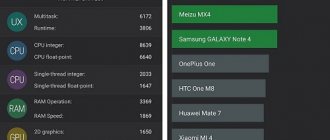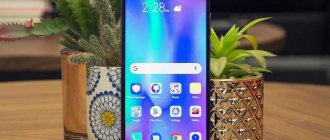Honor 10 should not be confused with Honor View 10 - these are different smartphones from Huawei that were released in 2021. The confusion is serious, although both flagships differ from each other even in appearance. We presented a review of Honor View 10 yesterday – you will find it here.
And now it’s time to look at Honor 10 - it just went on sale for 27,000 rubles (version with 64 GB of memory).
Characteristics
- OS: Android1 under EMUI 8.1.0 shell.
- Screen: IPS matrix with a diagonal of 5.84 inches. Full HD+ resolution: 2280×1080; pixel density – 432 per inch.
- Dual camera with resolutions: 16 and 24 megapixels. The apertures of the two modules are f/1.8.
- Front camera with a resolution of 24 megapixels and f/2.0 aperture.
- Processor: HiSilicon Kirin 970 with Mali-G72 MP12 video core. As of mid-2021, this is the most powerful solution from HiSilicon (a subsidiary brand of Huawei), which was previously used in the Mate 10 Pro and the new flagship Huawei P20. A special feature of the chip is the presence of a neural computing module to support AI technology.
- LTE modem cat.13, providing data transfer speeds of up to 400 Mbit/s in 4G networks.
- Set of interfaces: NFC, Bluetooth 4.2. There is even an infrared port for controlling household appliances. The Troika card is easily linked to NFC, plus it is possible to “link” three smartphones via NFC to simultaneously play one track. This will provide surround sound and volume. However, the phones must be connected to the same Wi-Fi network.
- There is face scanning technology for unlocking, although it does not work well. To remove the block on the face, the lighting must be ideal (the block cannot be removed in the dark). It will also not be possible to unlock a smartphone with glasses if the face was registered without them.
- 4 GB RAM and 64 GB memory. There is a version with 128 GB of memory.
- Battery 3400 mAh.
Taking into account the hardware, one would expect artificial intelligence technology for cameras in a smartphone, which itself determines the scene and sets the plot for it. The same “trick” is in the P20 and Honor View 10.
Design
Most users and reviewers call the smartphone beautiful, but in reality it has an Apple-inspired appearance with a disgusting “unibrow” at the top. It contains a speaker, front camera, proximity and light sensor. The frames are thin, the screen area is 86%.
A special feature is the Ultrasonic fingerprint scanner hidden under the glass (not the screen). The glass itself is presumably Corning Gorilla Glass 5. The back panel shimmers pleasantly and changes colors, which has already become a tradition for the Honor line. The two rear cameras with the small “Ai Camera” inscription stick out unpleasantly from the body - this is a technical drawback of the sensors themselves, which have a fixed thickness. The manufacturer manages to create a thin body, but cannot “fit” thick camera sensors with lenses into it.
On the bottom panel there is the popular USB Type-C, 3.5 mm jack and speaker. The presence of a wired headset jack will please many users who have cool headphones - they can be used with Honor 10.
In general, the design is standard - like most flagships.
conclusions
The Honor 10 smartphone can replace a simple camera for a beginner during trips and small events. Selfie lovers will love Huawei's built-in editor - it can be used to edit pictures without resorting to using special applications (although photos from Honor 10 turn out quite good even at the stage of taking a frame).
For a relatively affordable price (the cost of Honor 10 in August 2018 is 26,990 rubles) you will get a smart, impressive-looking device with a decent camera and high performance. If the presence of optical stabilization is not important to you, the device is quite good for its price.
Display Huawei Honor 10
Unlike other brands, Huawei is not yet seeking to purchase “tons” of Amoled screens from Samsung. Honor 10 uses a 5.84-inch IPS display with Full HD+ resolution and a pixel density of 432 per inch. LTPS technology was used in manufacturing, which provides wide viewing angles, more accurate color rendition, and lower power consumption.
There are many presets in the display settings - from “warm” to “cold”, the brightness level is high (also adjustable). The touchpad used recognizes up to 10 simultaneous touches. To save energy and improve performance, the resolution can be changed to a lower one, and “eye protection” is present, although there is nothing unusual about it.
Setting up the Huawei and Honor smartphone camera for selfie mode
To take a high-quality photo for social networks, it is recommended to use the “perfect selfie” option. To activate it you will need:
If you have any questions or complaints, please let us know.
- open the application and click on the icon that brings up decorations;
- scroll through the screen to open the Honor and Huawei camera settings menu;
- find the “perfect selfie” option in the proposed list and move the slider located next to it to the “on” position;
- save changes and return to photographing mode.
Then all that remains is to check the result.
Performance
HiSilicon Kirin 970 is the latest 10nm mobile chipset used in Huawei smartphones. The flagship module was previously installed in Mate 10 pro and P20, P20 Pro. Its potential is fully revealed, the capabilities are known, there is a built-in module for neural calculations, which is used to implement a “smart camera”.
In the Huawei P20 Pro set, we have already given the chipset parameters. If you're interested, here you go.
Cameras
Everyone in the know knows about Huawei’s cooperation with the Leica brand. If this collaboration takes place, then the Leica optics inscription appears next to the cameras. In Honor 10 there is no information about Leica’s work on cameras, but the unique operating principle of the two modules remains:
- The first module is a 16-megapixel color sensor with f/1.8 aperture optics. Its purpose is to collect information about the color of the scene.
- The second module is monochrome with a resolution of 24 megapixels and an f/1.8 aperture. It collects information about light.
The collected data is combined using a special algorithm, and the user receives a high-quality frame with accurate colors and visible details in dark and light areas of the scene. Only Huawei uses this dual-camera approach; other manufacturers use a second camera to determine depth of field.
Focusing in Honor 10 is instant, shooting with the Bokeh effect is present, 2x zooming is possible without loss of quality. Standard LED flash included.
The inscription AI CAMERA on the right side of the body indicates that the camera has its own intelligence. A special algorithm, thanks to the neuromodule in the Kirin 970 processor, recognizes the types of scenes to which the lenses are directed and sets the scene settings automatically. That is, the user points the camera at a forest at sunset, the program determines the type of scene and automatically sets the “landscape” settings. The result is a better shot than if the user took a photo with standard automatic settings without AI intervention. That is, the smartphone itself will turn on HDR, if necessary, set ISO, etc. Rarely is the type of scene or subject being photographed incorrectly. Huawei says that AI is capable of recognizing 500 types of scenes, accurately determining the contours of objects in the world and their location in space. All this takes photography to a new level. Or rather, Honor 10 simply supports this level, since the technology was previously implemented in the Huawei P20 Pro. But in any case, the 3-camera P20 Pro is much cooler in terms of photography - DxOMark studio put it in 1st place in the ranking of camera phones.
The camera application provides a professional mode, in which the user sets the ISO, shutter speed and other parameters.
Video shooting is top notch. The rear camera records 4K video at 30 FPS, Full HD video at 60 FPS. There is a slow motion mode in Full HD format at 120 FPS. There is nothing unique about this, and even the old iPhone 6 can do this. If there were content recording in Super Slo-mo (960 fps), it would be cool, but there is no such functionality, although the processor has potential.
The big minus of the camera is the lack of optical stabilization, which is a disaster for a flagship. Because of this, many shots in motion are blurred, and when shooting in low light, the lack of stabilization is noticeably more pronounced.
The front camera is almost standard - its 24 megapixel resolution allows you to take huge photos in the 5632x4224 format. And although there is only one camera, the background can be blurred under different shooting conditions. The same AI helps with this. Various reviewers praise the presence of artistic effects - so-called filters that are applied to the image after shooting. All this is complete nonsense and does not represent high value.
Examples of photos on Huawei Honor 10
Clickable.
How to properly set up the camera on Honor and Huawei phones
The easiest way to set up a smartphone and take high-quality photos is to use the device’s functionality. Usually, users just need to open the phone menu and change the current camera settings, adjusting it to their own needs.
It is important to note that there are no optimal, ideal settings, since different settings are suitable for different environmental conditions. Therefore, people who want to always take perfect pictures are advised to familiarize themselves with all the operating options of the device.
Restoring default settings
If the owner of the gadget is confused about the parameters, and attempts to return to the usual shooting conditions do not bring the desired result, he should restore the state of the camera to the basic level. To return to the standard operating procedure, you will need:
- open the photo app;
- expand the drop-down menu with a list of available actions (gear icon in the upper right corner of the screen);
- select the item that offers to return the device to its standard state.
Immediately after the reset, you can re-set up the camera and choose what shots you want to take.
Setting up the main camera
After restoring the basic operating conditions of the device, you can proceed to selecting new parameters for the main camera. Those who wish can:
- set the main lens settings, including resolution, brightness, contrast;
- indicate how to use zoom;
- select special modes that change the appearance of the photo and set a certain type of settings according to a template previously created by the developers;
- creating “live” pictures in gif format.
That is, photographers are offered a standard set of tools to change the appearance of photographs.
How to set up the front camera?
Preparing the front camera is much simpler, since here users will have to choose from two modes:
- standard, which involves the use of basic conditions and automatic adjustment of recording depending on the environment;
- portrait created for people shots and selfies.
The second option involves the use of a large number of filters that can change the appearance of the photo and add to it those features that the photographer wants to see. That is, for Instagram and other social networks it is recommended to use a portrait.
How to turn on the flash?
To turn on the flash for good photos in dark rooms or at night, you should enter the application and click on the lightning icon located in the upper left corner. Then all you have to do is select the appropriate flash mode:
- automatic – used in all shaded rooms when artificial intelligence decides that there is not enough natural light;
- included – for use in all photos;
- off – blocks the use of flash;
- always on - the purpose is obvious.
If you don’t like the selected mode, you can instantly change it.
Sound
Huawei is trying to follow HTC's example and make its phones multimedia. Honor 10 received an audio chip from the Asahi Kasei Microdevices brand with a 32-bit stereo channel and a headphone amplifier. The application offers 4 digital filters to give the sound different shades.
High-frequency audio transmission “over the air” is provided - a Bluetooth headset can be connected - aptX and aptX HD codecs are supported. In general, the sound from headphones (wired or not) will be awesome.











